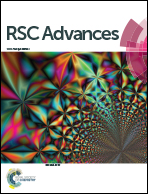Estrone removal by horseradish peroxidase immobilized on a nanofibrous support with Fe3O4 nanoparticles†
Abstract
The occurrence, fate, and removal of estrone (E1) from environmental systems have attracted considerable research interests in recent years because of the potential risks of human and wildlife exposure to E1. This study aims to develop an efficient enzymatic method to remove E1 from water. Electrospinning composite fibers (200–300 nm in diameter), comprising poly(vinyl alcohol) (PVA), poly(acrylic acid) (PAA), SiO2, and Fe3O4 nanoparticles (NPs), were used as supports for horseradish peroxidase (HRP) immobilization. The immobilized HRP was used for E1 removal. The effects of Fe3O4 NPs on the degradation and adsorption of E1 by the prepared materials were investigated. The results showed that the immobilized HRP was less sensitive to the changes in pH and temperature compared with free HRP. The immobilized HRP also exhibited relatively high stability and reusability. HRP-PAA/PVA/SiO2 nanofibrous membranes with Fe3O4 NPs (HRP-Fe3O4 NPs/NFM) showed a significantly higher relative activity for E1 removal (84.5%) than the nanofibrous membranes without Fe3O4 NPs (79.4% P < 0.05). This improvement can be attributed to the addition of Fe3O4 NPs which increased the adsorption ability of the membranes and improved the catalytic activity of the immobilized HRP. The HRP-Fe3O4 NPs/NFM is suitable for use in wastewater treatment owing to its high reusability.


 Please wait while we load your content...
Please wait while we load your content...